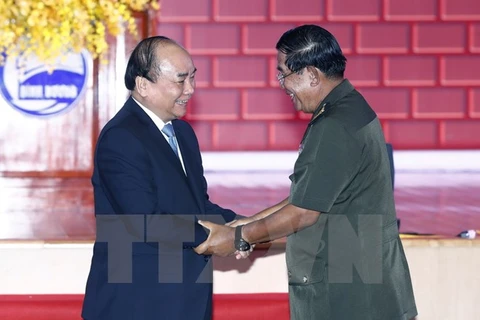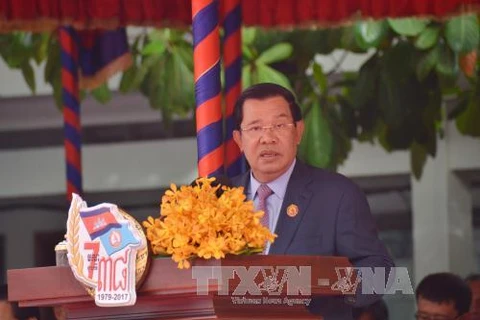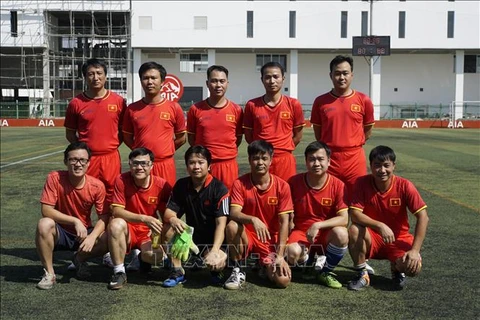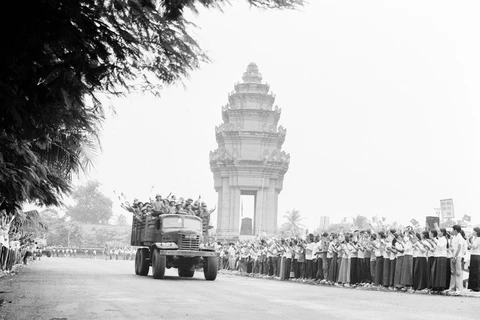 The southwestern border defence war and the war against the Pol Pot genocidal regime has passed four decades, however the pain of huge losses still deeply hurts the poor land of Ba Chuc, Tri Ton in An Giang province. A grave house was built in 1979, keeping 1,159 remains of local people that were brutally murdered during the war. The grave house is like an eternal symbol of Pol Pot's crimes in the past (Photo:VNA)
The southwestern border defence war and the war against the Pol Pot genocidal regime has passed four decades, however the pain of huge losses still deeply hurts the poor land of Ba Chuc, Tri Ton in An Giang province. A grave house was built in 1979, keeping 1,159 remains of local people that were brutally murdered during the war. The grave house is like an eternal symbol of Pol Pot's crimes in the past (Photo:VNA)  More than 40 km away from Chau Doc town to the southwest, Ba Chuc grave house has a quiet look, covering the painful remnants of the genocidal period of Pol Pot. (Photo: VNA)
More than 40 km away from Chau Doc town to the southwest, Ba Chuc grave house has a quiet look, covering the painful remnants of the genocidal period of Pol Pot. (Photo: VNA)  On April 18, 1978, Pol Pot troops rushed into Ba Chuc, slashing and killing innocent civilians. More than 3,000 local people were brutally executed within 12 days and only three people survived after the massacre. In 1979, An Giang provincial authorities and people built a population of criminal evidence, including seven categories: grave house, memorial monument, house of tradition, pavilion, lotus pond, guest house and guard rail. (Photo: VNA)
On April 18, 1978, Pol Pot troops rushed into Ba Chuc, slashing and killing innocent civilians. More than 3,000 local people were brutally executed within 12 days and only three people survived after the massacre. In 1979, An Giang provincial authorities and people built a population of criminal evidence, including seven categories: grave house, memorial monument, house of tradition, pavilion, lotus pond, guest house and guard rail. (Photo: VNA)  The quiet tomb area is hexagonal; each corner is a pillar supporting the roof of the house with the image of a bloody sword grip. In the middle is an 8-frame glass, containing 1,159 skeleton bones. (Photo: VNA)
The quiet tomb area is hexagonal; each corner is a pillar supporting the roof of the house with the image of a bloody sword grip. In the middle is an 8-frame glass, containing 1,159 skeleton bones. (Photo: VNA)  The wooden puncher that Pol Pot troops used to smash head, slaughter the people of Ba Chuc. The traces of old executions are still intact in the scratches of the pestle that are deeply ingrained in the head of the awl. (Photo: VNA)
The wooden puncher that Pol Pot troops used to smash head, slaughter the people of Ba Chuc. The traces of old executions are still intact in the scratches of the pestle that are deeply ingrained in the head of the awl. (Photo: VNA)  Phi Lai pagoda is located at the foot of Tuong mountain. The mountain is located in Ba Chuc town (Tri Ton, An Giang). On April 18, 1978, Pol Pot stormed into Phi Lai pagoda and a mass execution took place at this temple (Photo:VNA)
Phi Lai pagoda is located at the foot of Tuong mountain. The mountain is located in Ba Chuc town (Tri Ton, An Giang). On April 18, 1978, Pol Pot stormed into Phi Lai pagoda and a mass execution took place at this temple (Photo:VNA)  The 10m long wall is spotted by bloodstains of Ba Chuc people in the horrifying massacre that killed over 200 people. More than 40 years have passed, but the blood still cannot fade. (Photo: VNA)
The 10m long wall is spotted by bloodstains of Ba Chuc people in the horrifying massacre that killed over 200 people. More than 40 years have passed, but the blood still cannot fade. (Photo: VNA) VNA




























